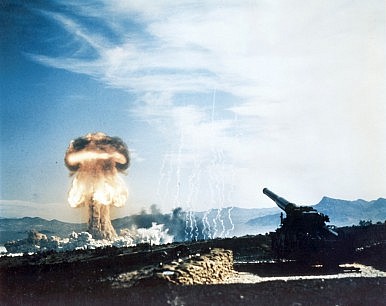Pakistan Develops Low-Yield Smart Nuclear Weapons
By Abdus Sattar Ghazali
21 October, 2015
Countercurrents.org

Foreign secretary of Pakistan, Aizaz Chaudhry, has confirmed that his country has made low-yield nuclear weapons to deal with India's so-called cold-start doctrine that envisages limited war against Pakistan.
Briefing the Pakistani media on Prime Minister Nawaz Sharif’s visit to Washington, Chaudhary also said that Pakistan would not sign any nuclear deal with the United States during the visit. Sharif will hold a meeting with US President Barack Obama on October 22.
Under India's Cold Start doctrine, Indian conventional forces would conduct coordinated offensive operations into Pakistan and conduct limited warfare. The Cold Start emphasizes speedy and lithe offensive incursions into Pakistan. Announced in April 2004, Cold Start represents a marked departure from the fundamentally defensive orientation of the Indian Army.
According to The Diplomat of Tokyo, "from the Pakistani perspective, battlefield use of tactical nuclear weapons would stop Indian forces dead in their tracks. Unsaid in Chaudhary’s remarks on Pakistan’s tactical weapons is the notion that Pakistan would essentially resort to nuclear weapon use on its own territory to slow down an Indian advance."
Both India and Pakistan are self-declared nuclear powers that, ever since the two countries’ independence from Britain in 1947, have claimed control of Kashmir. This has made the area a dangerous flashpoint several times during the past seven decades.
It may be pointed out that There have been persistent reports that Pakistan was developing smart nuclear weapons. However, it is the first time that a senior Pakistani official has given an explanation of the country's decision to make tactical nuclear weapons, renaming it as the country's proactive strategy.
According to a July 2013 report by Terminal X (TX), Pakistan's authoritative portal on global defense, intelligence and geopolitics:
"Over the past few years, Pakistan’s strategic forces, responsible for the country’s primary deterrence program, have been doing extensive research into the design and development of smart weapons i.e. nuclear weapons that have a dynamic and compact form, and which can easily be transported from one location to another. Although a variety of warheads already exist, especially in northern Pakistan, these enhanced productions are considered a landmark in strategic deterrence, owing to their size and power."
Sources for Terminal X revealed that Pakistan has taken the term ‘special degree’ one step ahead by developing what they call, “the world’s smallest nuclear weapons”.
Terminal X also said that reportedly, these special weapons are about the size of a tennis ball (which can easily be hand-picked). Officials familiar with the development said that Pakistan’s Strategic Forces Command made it clear it has not signed any treaty preventing it from taking an aggressive reaction (in defense, when provoked or attacked by a hostile enemy).
Alarmingly, the Terminal X also said that if any mistake was made to initiate force aggression against Pakistan, then these ball-sized nuclear weapons will also be distributed across the Muslim world’s armed forces. In addition to these smart weapons, the Pakistani military has developed plutonium-based anti tank bullets which can prove very lethal for enemy armored vehicles, especially those of neighboring India.
U.S. dropped low-yielding nuclear devices in Afghanistan, Iraq
Tellingly, there were reports that the US has used low-yielding nuclear or Depleted Uranium (DU) devices in Afghanistan and Iraq while Israel used similar weapons during its aggression on South Lebanon in 2006.
The first detonation of a nuclear weapon against another country since 1945 took place approximately 11 miles east of Basra, sometime between February 2 and February 5, 1991during the first Gulf War, according to William Thomas, a U.S. Army veteran who wrote in 2007 under the headline, US dropped nuclear bombs on Afghanistan and Iraq. He went on to say: "With the city of Basra resounding to gigantic explosions, and engulfed in "a hellish nighttime of fires and smoke so dense that witnesses say the sun hasn't been clearly visible for several days at a time," a 5-kiloton GB-400 nuclear bomb exploding 11 miles away under the desert attracted no notice."
"Under the cover of massive DU-tipped bombs that raised dirty mushroom clouds in thunderous explosions that rained radioactive dust over Jalalabad and nearby villages, the first nuclear bombs dropped since Basra in 1991 were detonated by American forces in Afghanistan beginning in March 2002. Before their field tests were concluded, United States forces would explode four 5-kiloton GBU-400 nuclear bombs in Tora Bora and other mountainous regions of Afghanistan," Thomas added.
In his book Towards a World War III Scenario: The Dangers of Nuclear War Michel Chossudovsky says the US Congress okayed the use of tactical nuclear weapons in non-conventional wars in 2003. According to congressmen it was quite “safe for civilians”.
Interestingly, in May 2015, Clark Murdock, a senior adviser with the Center for Strategic and International Studies wrote that the United States should develop new low-yield, tactical nuclear weapons to deter countries from seeking nuclear weapons of their own.
Murdock, the co-author of Project Atom” report, argues the Pentagon needs a more diverse suite of nuclear weapons. “In order to execute its Measured Response strategy, the nuclear forces for both deterrence and extended deterrence should have low-yield, accurate, special-effects options that can respond proportionately at the lower end of the nuclear continuum,” he writes.
“Project Atom” report of the Center for Strategic and International Studies was produced by Murdock and eight co-authors as a “zero-based, blue-sky” look at American’s nuclear arsenal.
Abdus Sattar Ghazali is the Chief Editor of the Journal of America (www.journalofamerica.net) Email: asghazali2011 (@) gmail.com.


